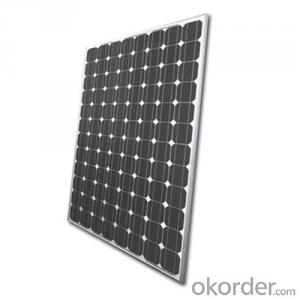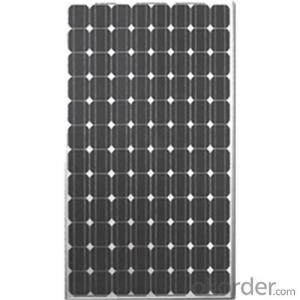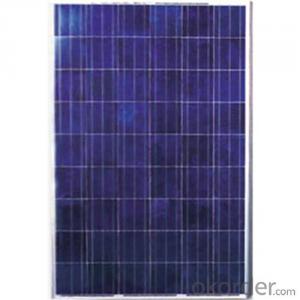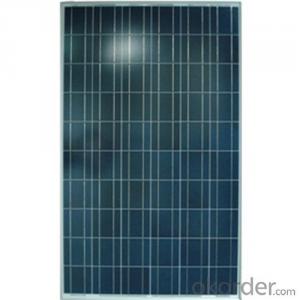Monocrystalline Solar Panel 265W Made in China
- Loading Port:
- Shanghai
- Payment Terms:
- TT OR LC
- Min Order Qty:
- 6000 watt
- Supply Capability:
- 6700000 watt/month
OKorder Service Pledge
OKorder Financial Service
You Might Also Like
Item specifice
Benefits of Solar Power:
Following to RMI, Balance-of-System (BoS) elements, this is, non-module cost of non-microinverter solar modules (as wiring, converters, racking systems and various components) make up about half of the total costs of installations.
For merchant solar power stations, where the electricity is being sold into the electricity transmission network, the cost of solar energy will need to match the wholesale electricity price. This point is sometimes called 'wholesale grid parity' or 'busbar parity'
Specifications of Mono Solar Panel
Average pricing information divides in three pricing categories: those buying small quantities (modules of all sizes in the kilowatt range annually), mid-range buyers (typically up to 10 MWp annually), and large quantity buyers (self-explanatory—and with access to the lowest prices). Over the long term there is clearly a systematic reduction in the price of cells and modules. For example in 2012 it was estimated that the quantity cost per watt was about US$0.60, which was 250 times lower than the cost in 1970 of US$150.
Real world prices depend a great deal on local weather conditions. In a cloudy country such as the United Kingdom, price per installed kW is higher than in sunnier countries like Spain.
Mechanical data and design
Format | 156mm x 156mm±0.5mm |
Thickness | 210μm±40μm |
Front(-) | 1.5mm bus bar (silver),blue anti-reflection coating (silicon nitride) |
Back (+) | 2.5mm wide soldering pads (sliver) back surface field (aluminium) |
Temperature Coefficient of Cells
Voc. Temp.coef.%/K | -0.35% |
Isc. Temp.coef .%/K | +0.024%/K |
Pm.Temp.coef. %/K | -0.47%/K |
Electrical Characteristic
Effiency(%) | Pmpp(W) | Umpp(V) | Impp(A) | Uoc(V) | Isc(A) | FF(%) |
18.35 | 4.384 | 0.526 | 8.333 | 0.63 | 8.877 | 78.39% |
18.20 | 4.349 | 0.526 | 8.263 | 0.63 | 8.789 | 78.54% |
18.05 | 4.313 | 0.525 | 8.216 | 0.63 | 8.741 | 78.32% |
17.90 | 4.277 | 0.524 | 8.161 | 0.625 | 8.713 | 78.04% |
17.75 | 4.241 | 0.523 | 8.116 | 0.625 | 8.678 | 77.70% |
17.60 | 4.206 | 0.521 | 8.073 | 0.625 | 8.657 | 77.36% |
17.45 | 4.170 | 0.519 | 8.039 | 0.625 | 8.633 | 76.92% |
17.30 | 4.134 | 0.517 | 8.004 | 0.625 | 8.622 | 76.59% |
17.15 | 4.096 | 0.516 | 7.938 | 0.625 | 8.537 | 76.80% |
17.00 | 4.062 | 0.512 | 7.933 | 0.625 | 8.531 | 76.18% |
16.75 | 4.002 | 0.511 | 7.828 | 0.625 | 8.499 | 75.34% |
16.50 | 3.940 | 0.510 | 7.731 | 0.625 | 8.484 | 74.36% |
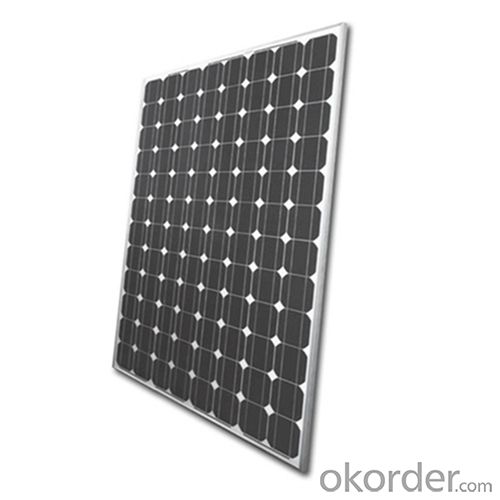

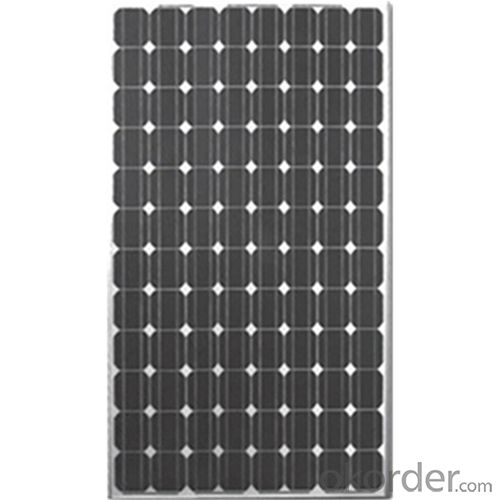
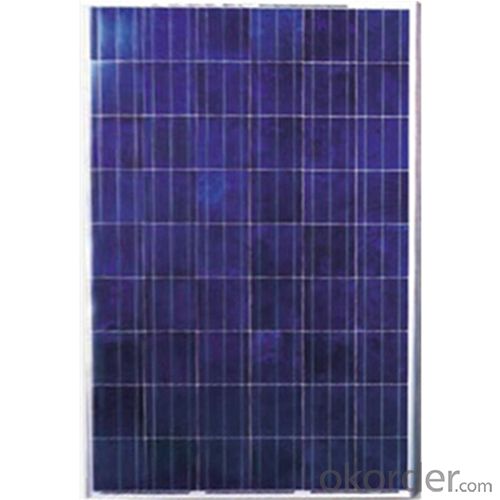
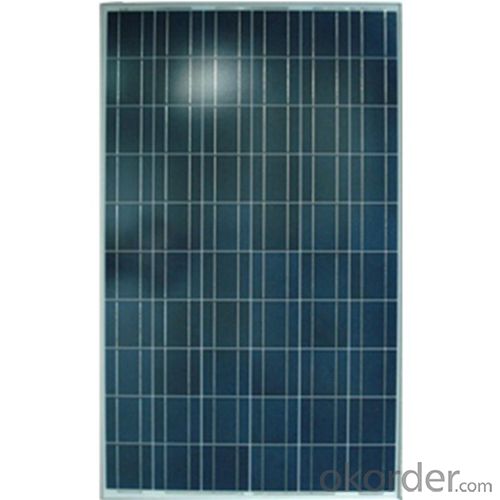
FAQ
Q: Do you have the CE, TUV, UL Certification?
A: We’ve already passed all the tests, and any certificate is available.
Q: Can you provide the peripheral products of the solar panels, such as the battery, controller, and inverter? If so, can you tell me how do they match each other
A: Actually we are only manufacturer of solar panels, but we could try to source them for you in China if you need. We could provide you an optimal system design to instruct you how to install.
Q: What is your warranty system?
A: For c-Si panel: 25years output warranty for no less than 80% of performance, 10 years output warranty for no less than 90% of performance. Free from material and workmanship defects within 5 years.
For a-Si panel: 20 years output warranty for no less than 80% of performance, 10 years output warranty for no less than 90% of performance. Free from material and workmanship defects within 2 years.
- Q:How do solar panels affect roof aesthetics?
- Solar panels can have both positive and negative effects on roof aesthetics. On one hand, solar panels can enhance the look of a roof by providing a sleek and modern appearance, especially when integrated seamlessly into the roof design. On the other hand, some may argue that solar panels can detract from the overall aesthetic appeal of a roof, particularly if they are bulky or installed in a way that is visually obtrusive. However, with advances in solar panel technology, it is now possible to find more aesthetically pleasing options that blend well with different types of roofs, making them a viable option for homeowners concerned about both energy efficiency and the visual appeal of their roofs.
- Q:Can solar panels be used for powering a hotel or hospitality establishment?
- Yes, solar panels can definitely be used for powering a hotel or hospitality establishment. Solar energy is a clean and sustainable source of power, and installing solar panels can significantly reduce energy costs for the establishment. Additionally, hotels often have large rooftops or open spaces that are suitable for installing solar panels, making it a practical and efficient solution for meeting their energy needs.
- Q:Can solar panels be installed on historical landmarks or monuments?
- Yes, solar panels can be installed on historical landmarks or monuments with careful planning and consideration to preserve the architectural integrity and cultural significance of the site.
- Q:I don't have a regulator connected as they are a little expensive for a pensioner, If I join the panels into line to the battery bank from the roof should that be OK.?
- You can do this, but it isn't the best way to go. There is no problem with joining the solar panels. There are two ways to do this, in series and in parallel. A series combination will add the voltages that each panel is producing together, but not the amperages. For example, if five panels are producing 6V at 300mA each, the end result will be 30V at 300mA for a series array. A parallel combination combines the amperages of all the panels, but not the voltages. So, in our earlier example, five panels at 6V and 300mA would provide 6V and 500mA (.5A) if wired in parallel. Series-parallel combinations are also possible, giving some of the benefits of each method. This would probably better understood by doing a quick search on Google Images for series, parallel, and series-parallel. You CAN connect the solar panels directly to your battery bank with no regulator. Unfortunately, without a regulator, the connection is two-way. When the sun is out and the solar panels are producing more voltage than the batteries, the batteries will charge. However, when the panels are producing less voltage than the batteries, the batteries will instead send power into the solar panels, which will be dissipated and wasted. The panels may charge your batteries during the day, but they will discharge them at night.
- Q:How long does it take a 5 watt, 2 volt solar panel to charge a 2 volt R.V. battery?
- Most solar panels have something called a charge controller on them. This prevents electricity from going backwards from the battery to the panel. Solar panels are rated at 2V but they do put out a little more than that during full sun operation. You didn't specify the size of your battery but it really doesn't matter. It comes down to your consumption of power. If you are only charging the RV battery so it maintains a charge when you don't use it very much, a 5 watt panel is fine. It will charge the battery and keep the small drains on the battery from making it go dead ( the clock radio, the theft deterrent system, etc use power even when RV is off) But if you are using the battery to run things when you are parked, you probably don't have a big enough panel. If you use a 30watt fluorescent light and a 00 watt laptop, you need 30 watts of power saved up every hour in your battery and that's with no inefficiencies. So if your panel puts out 5 watts an hour and you are using 30 watts an hour, you need 30 watts/ 5 watts = 9 hours minimum of charge time to run your stuff for just one hour. You probably need a panel of around a 00 watts to get any meaningful use of your battery. Plus, you never want to run your battery to full drain because it ruins the plates inside the battery. Watts = volts x amps. If you have 2 volts panels, you would charge at 8 amps with a 00 watt panel. This is a good charge rate. Any more than this and you risk warping the plates with too much heat.
- Q:All I ever heard is how easy it is to get solar panels for a persons home. I live in Arkansas and to do my house it would cost 25000 that I dont have and No state incentives. So where do I go and get these free solar panels? Thanks for the help
- Sorry this is so long. I live in north west arkansas. I have solar on my home. I installed them myself. Did not cost me anywhere near 25 grand. Solar will pay you back if you get incentives or not. I have said this a hundred times but people just don't seem to understand or can't do the math. You are renting from the public utility. You have nothing in the end but a stack of payment stubs. There is no way to get a return on your investment. You paid them money and have nothing. Nothing at all .. Well maybe good service. But still nothing. If you check it out most solar electric systems last 30 years or longer. If your electric bill is 00 dollars a month. do the math. 00 dollars a month for 30 years is $36,000 dollars you would normally pay the public utility. So why not buy your $25,000 system, you just made $0,000 right there on the spot. Now add in 3.5% cost of living per year for each year for the next 30 years on that 35,000 you pay the public utility. Then you have to keep in mind you do not pay taxes on any electric you make yourself. You do not pay fees on your own power. You do not pay the cost of fuel incresses every time the price of oil goes up. In the end you saved $00,000. So it is free even if Arkansas don't give free handouts like other states. I even know people who say they are waiting for some one to make a cheaper solar module. That will not happen because even if they make it for half the cost (like evergreen is doing) it will still be sold at standard market value not production cost. The real problem with solar is it is hard to come up with the upfront cost. But renting solar panels is comming but that is the same as just renting power from the public utility. I wish you luck but it will be a while before Arkansas will make any moves on renewables. They just in 2007 made it law that the public utilities have to let your roll your net metering over to the next month if you over produced.
- Q:Can solar panels be used in off-grid systems?
- Yes, solar panels can be used in off-grid systems. Off-grid systems are designed to operate independently from the electrical grid, and solar panels can generate electricity from sunlight, making them a reliable and sustainable source of power for off-grid applications.
- Q:i really need to know howbecause im building a solar powered car for science fair :]thank you!
- Have okorder . This can surely guide anyone!
- Q:Hi! I bought a Coleman 2 vdc cooler that pulls 9 amps. What size solar panel and amp-hour battery do I need? I only open it 3 times a day. It will hold about 3 gals of milk.
- If it pulls 9 amps continuously, that's 08 watts/hour or about 2.5 kwh/day. If it only pulls half that (does it cycle?) it's about .2 kwh/day. You only want to drain a lead-acid battery 50% or so, so you'll want a 5 or 2.5 kwh battery pack. A typical setup for the 5 kwh would be two L-6 batteries in series, and for the 2.5 kwh you could use 2 T-05 batteries in series. This does not account for days of cloud. If you regularly have cloudy days, size the battery pack for two or three days of use with no input (2-3 x the sizes given above). To charge them, you typically want panels that will charge your battery at least 5% of its capacity per hour (C/20). For 2 volt nominal panels that's 0 amps for the T-05 or 20 amps for the L-6 batteries. It's good to have more than that for battery life (it cuts down on what's called stratification), so you'll want probably 50-200 watts of panels for the T-05 and 300-400 for the L-6. You'll also need a charge controller. Peltier coolers are very inefficient. You'll save money by using a regular mini-fridge and an inverter. Most mini-fridges only draw 50 watts or so, so you're talking 600 watt-hours for a 50% duty cycle. This means two T-05 batteries will give you two days of use and you'll only need 20-50 watts of panel. DK
- Q:I have just made my first dolar panel 20 watts, charges my 27TMX Trojan battery perfectly. Now I am thinking to build more solar panels for a grid tie installation at my house, maybe 5 panels would do it, is this safe?
- Homemade okorder
1. Manufacturer Overview |
|
|---|---|
| Location | |
| Year Established | |
| Annual Output Value | |
| Main Markets | |
| Company Certifications | |
2. Manufacturer Certificates |
|
|---|---|
| a) Certification Name | |
| Range | |
| Reference | |
| Validity Period | |
3. Manufacturer Capability |
|
|---|---|
| a)Trade Capacity | |
| Nearest Port | |
| Export Percentage | |
| No.of Employees in Trade Department | |
| Language Spoken: | |
| b)Factory Information | |
| Factory Size: | |
| No. of Production Lines | |
| Contract Manufacturing | |
| Product Price Range | |
Send your message to us
Monocrystalline Solar Panel 265W Made in China
- Loading Port:
- Shanghai
- Payment Terms:
- TT OR LC
- Min Order Qty:
- 6000 watt
- Supply Capability:
- 6700000 watt/month
OKorder Service Pledge
OKorder Financial Service
Similar products
New products
Hot products
Hot Searches
Related keywords

